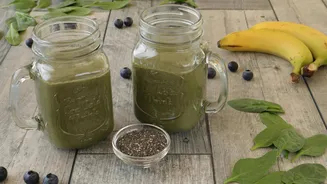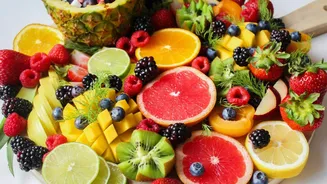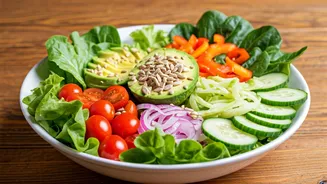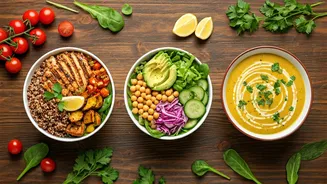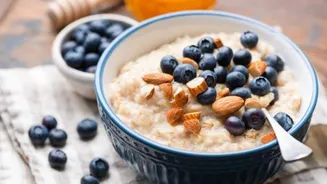Salads: A Healthy Start
Salads are a cornerstone of healthy eating, offering a versatile base for a variety of nutrients and flavors. They are not merely a side dish; they can
be a complete meal, providing essential vitamins, minerals, and fiber. The beauty of salads lies in their adaptability, allowing for endless combinations of vegetables, fruits, proteins, and dressings. This makes them a great option for people with different dietary requirements. Moreover, salads are quick and easy to prepare, making them ideal for busy individuals or families looking for a convenient way to eat nutritious food. By incorporating salads into your diet, you are choosing a path towards improved overall health and well-being. This guide offers numerous options to create refreshing and fulfilling salads that cater to different tastes and preferences.
Refreshing Green Salads
Green salads form the foundation of many healthy eating plans. These salads prioritize leafy greens, such as lettuce, spinach, kale, and arugula, which are packed with vitamins A, C, and K, as well as essential minerals. Consider a simple yet satisfying garden salad featuring mixed greens, cucumbers, cherry tomatoes, and a light vinaigrette. For added protein and flavor, you can include grilled chicken or tofu. Another option includes a spinach salad with strawberries, walnuts, and a balsamic glaze, combining sweet and savory elements. A kale salad with lemon juice, olive oil, and parmesan cheese offers a more robust flavor profile. To enhance texture and nutritional value, include ingredients such as avocado, seeds, and nuts. Regularly consuming green salads promotes digestive health, boosts energy levels, and provides the body with vital nutrients.
Vibrant Vegetable Creations
Beyond leafy greens, vegetable-based salads incorporate a wide array of colorful and nutritious produce. A Mediterranean salad, for instance, blends cucumbers, tomatoes, bell peppers, red onion, Kalamata olives, and feta cheese, dressed with a zesty lemon-herb vinaigrette. This salad is rich in antioxidants, healthy fats, and probiotics. A classic coleslaw, made from shredded cabbage, carrots, and a creamy dressing, provides a refreshing crunch, while a roasted vegetable salad with zucchini, eggplant, and bell peppers offers a smoky, caramelized taste. Incorporating roasted vegetables not only enhances the flavor but also concentrates their natural sweetness and nutrient content. Ensure variety by adding ingredients such as corn, beets, and radishes, each offering distinct flavors and textures. Vegetable salads are an excellent way to incorporate a diverse range of vitamins, minerals, and fiber into your daily diet.
Fruit-Infused Delights
Salads can also celebrate the natural sweetness and textures of fruits, making them a refreshing and satisfying option, particularly during warmer weather. A fruit salad with mixed berries, melon, and a light honey-lime dressing is an easy and delicious choice. For a more substantial salad, combine mixed greens, grilled chicken or shrimp, and a variety of fruits like oranges, grapes, and apples, complemented by a poppy seed dressing. A spinach salad with mandarin oranges, toasted almonds, and a raspberry vinaigrette offers a balance of sweet, tangy, and crunchy elements. Fruit salads are packed with antioxidants and natural sugars, providing a healthy alternative to desserts and snacks. Experiment with seasonal fruits to enjoy a constantly evolving variety of flavors and nutrients. Incorporating fruits into your salads adds vibrant colors and boosts overall health and wellness.
Protein-Packed Power Bowls
Protein-rich salads are perfect for a complete and satisfying meal. These salads include a variety of protein sources to help sustain energy levels and promote muscle health. Consider a quinoa salad with black beans, corn, avocado, and a lime-cilantro dressing. This combination offers a blend of complex carbohydrates, protein, and healthy fats. A salad with grilled chicken or fish, mixed greens, hard-boiled eggs, and a light dressing creates a balanced meal. Another great option is a salad featuring chickpeas, vegetables, and a tahini dressing. For a vegetarian choice, include tofu, tempeh, or edamame to boost the protein content. These salads provide essential amino acids and nutrients that are critical for overall health and well-being. Tailor your salads to match your fitness goals and dietary preferences to create a filling and nutritious meal.
Dressings: The Finishing Touch
Dressings play a pivotal role in the taste and nutritional profile of a salad. Making your own dressings allows you to control the ingredients, avoiding excessive sugars, sodium, and unhealthy fats. Simple vinaigrettes made from olive oil, vinegar (balsamic, red wine, or apple cider), and herbs (such as basil, oregano, and thyme) are a healthy and flavorful choice. Creamy dressings, such as those based on Greek yogurt, tahini, or avocado, add richness while providing extra nutrients and probiotics. A honey-mustard dressing provides a sweet and tangy flavor, while a lemon-herb vinaigrette offers a refreshing zest. Experimenting with different combinations and flavors to elevate your salads is encouraged. The key is to choose dressings that complement the ingredients in your salad and enhance the overall taste and nutritional value. Dressings are more than just a flavor enhancer; they are essential for creating a satisfying and balanced meal.
Salad Preparation Tips
Preparing salads involves a few key steps to ensure the final product is delicious and enjoyable. Washing and drying your greens and other vegetables is crucial to remove any dirt or residue and to achieve a crisp texture. Pre-chopping ingredients in advance saves time during meal preparation. Storing salad ingredients separately—such as dressing, greens, and other components—prevents the salad from becoming soggy. Consider using a salad spinner to dry greens effectively. When assembling the salad, add the dressing just before serving to maintain the texture and flavor of the greens. For transport, pack the dressing separately and combine all the ingredients right before eating. By following these preparation tips, you can ensure that your salads are fresh, flavorful, and a delight to eat. These steps ensure your salads are a culinary success.
Customizing for Dietary Needs
Salads are highly adaptable to various dietary requirements. For vegan eaters, swap out animal products for plant-based alternatives like tofu, tempeh, beans, or nuts. Gluten-free salads are easy to create by selecting ingredients that naturally lack gluten, such as rice noodles, quinoa, and a variety of vegetables and proteins. People with nut allergies should be mindful of toppings and dressings, ensuring that they choose alternatives like seeds or sunflower butter. When making salads for people with allergies, thoroughly check the ingredient labels to avoid allergens. Always be aware of cross-contamination issues in shared preparation spaces. By tailoring your salad choices, you can create delicious and nutritious meals. It is possible to adapt salads to fit different health needs, making them a fantastic dietary staple. Be careful in avoiding ingredients that trigger an allergic reaction and ensure the dietary safety of your salads.
Beyond the Basics: Creativity
Salad creation is an opportunity to embrace creativity and experimentation. Try different combinations of textures, flavors, and colors. Explore various cuisines, using ingredients and dressings inspired by international dishes, such as Asian-inspired salads with sesame-ginger dressing or Mediterranean salads with a lemon-herb vinaigrette. Add crunchy elements such as toasted nuts, seeds, croutons, or crispy wontons. Include fresh herbs to provide vibrant flavor notes. Don't be afraid to add fruits, vegetables, and proteins. Embrace new ingredients that you have not used before to broaden your flavor profiles. By being creative and trying out different ingredients, you can make salads that are exciting, enjoyable, and packed with health benefits. You may also invent your own salad recipes. The more innovative you get, the more likely you are to create satisfying meals.
Salads for Every Occasion
Salads are versatile and suitable for any occasion, from casual weeknight dinners to elegant gatherings. They are great as a side dish, a main course, or even a light snack. Prepare a large batch of salad to eat throughout the week as a way to promote a healthy diet. For potlucks or parties, create a colorful and crowd-pleasing salad with a variety of ingredients. When hosting a dinner party, consider preparing several different types of salads to accommodate various tastes and dietary restrictions. Salads are also ideal for picnics and packed lunches. Their versatility makes them an excellent option in all settings. Whether you are hosting a formal event or preparing a meal for yourself, salads offer a convenient and healthy way to add nutrition to any event or meal plan. With a little creativity, you can enjoy salads for any occasion.



